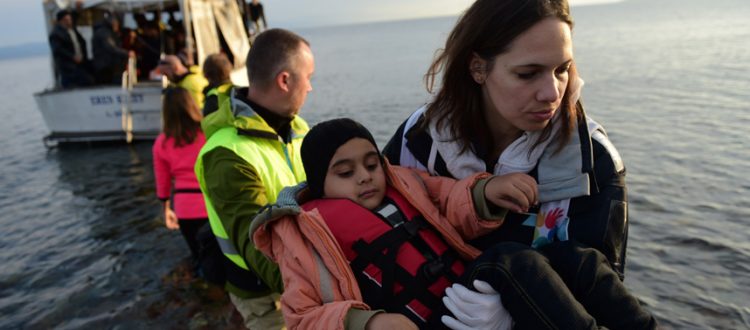Young refugees and peacebuilding – a missing link
The ability and willingness of young people to build networks across social lines, engage in creative problem solving and act as community leaders presents an opportunity for bottom-up change.
| Suggested Reading | Conflict Background | GCCT |
By Dylan Jones and Matilda Flemming
There are today almost 60 million forcibly displaced people around the world. To put that in perspective, that’s a number fairly equal to the population of Italy. The most recent figures show that 51% of these displaced people are under the age of 18. Whilst there is no data available for those under 25 or 30, the youth demographic in most conflict-affected countries allows us to safely conclude that young people make up the vast majority of this enormous group.
From long-running refugee camps such as Dadaab in Kenya, to more recent crossings into Europe on the Mediterranean, and increasingly protracted situations across Southeast Asia, we know that a range of solutions are desperately needed. Trends are also changing. The traditional image of refugees living in large, concentrated camps is no longer the most accurate picture –58% of refugees today live in cities. For those that have left their community or country, they are constantly faced with a lack of services – including healthcare and education – in uncertain situations where they may be excluded, considered illegal, at risk of discrimination and violence. These risks are compounded for women and girls; sexual based violence and the nationality of children with single mothers raise immediate protection issues, whilst access to livelihood opportunities, education and healthcare remain restricted – particularly for women-headed households.
Peacebuilding and refugee work is still largely undertaken in separate ways, with different donors, specialists and program directions. Yet, with the increasingly protracted and urban situation of refugees, both fields must recognize the role of refugees as change agents to promote social cohesion and strengthen their resilience to thrive in difficult environments. Women and girls are central to this. We need to ensure they are protected. We must also go beyond this, to partner with them, listen to their needs and support their active participation for sustainable action. We have already seen wonderful examples of the impact that this connected work can have. Peace education has effectively helped to transform conflict in refugee camps and youth engagement has broken down social barriers to reduce violence in urban situations.
There is a growing recognition of collaboration needed between the two fields. The recently passed UN Security Council Resolution 2250 highlights the need for increased support for youth in peace efforts by a number of entities, including the UN High Commissioner for Refugees (UNHCR). This has also been raised by UNHCR itself in its Urban Refugee Policy of 2009 – emphasising the need to expand ‘protection space’, which includes the enjoyment of harmonious relationships with host populations, other refugees and migrant communities.
So, how can youth peacebuilding play a role? Youth- and refugee-led organisations have a significant impact for refugee communities despite their limited resources. The ability and willingness of young people to build networks across social lines, engage in creative problem solving and act as community leaders presents an opportunity for bottom-up change. By investing in the development, participation and leadership of young refugees, we can:
- Better understand the needs and concerns of refugee communities.
- Bring the voice of young refugees to policy makers.
- Address root causes of damaging conflict and enhance social cohesion.
This impact will only be felt when political, financial, technical and logistical support is provided to youth and refugee groups to identify and lead the implementation of sustainable solutions.
Dylan Jones, is a member of UNOY Peacebuilders’ Youth Advocacy Team. Matilda Flemming, is former Leading coordinator at the UNOY Peacebuilders International Secretariat.
This article was originally published on UNOY Peacebuilders’ website and is available by clicking here. The views expressed in this article do not necessarily reflect the views of TransConflict.




















RT @TransConflict: Young refugees and peacebuilding – a missing link: The ability and willingness of young people to … https://t.co/zj01f…
RT @TransConflict: Young refugees and peacebuilding – a missing link: The ability and willingness of young people to … https://t.co/zj01f…
Pingback : Young refugees and peacebuilding – a miss...
Young #refugees and #peacebuilding – a missing link – https://t.co/yMSHVdMFrf
Young #refugees and #peacebuilding – a missing link – https://t.co/1FAVDQ66Pv
RT @TransConflict: Young refugees and peacebuilding – a missing link: The ability and willingness of young people to … https://t.co/zj01f…
Young #refugees and #peacebuilding – a missing link, by @unoy_peace – https://t.co/1FAVDQ66Pv
Young #refugees and #peacebuilding – a missing link, by @unoy_peace – https://t.co/yMSHVdMFrf
RT @TransConflict: Young #refugees and #peacebuilding – a missing link, by @unoy_peace – https://t.co/1FAVDQ66Pv
Young #refugees and #peacebuilding – a missing link https://t.co/IFIuqPBoMM via @TransConflict
RT @max_f_diana: Young #refugees and #peacebuilding – a missing link https://t.co/IFIuqPBoMM via @TransConflict
Pingback : The seventeenth GCCT newsletter - TransConflict